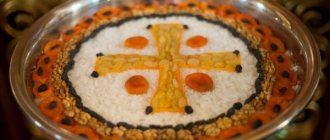50 years after the death of Saint Theodore, Emperor Julian decided to abuse Christians; he ordered his mayor to sprinkle all food supplies. But he only ordered the supplies to be sprinkled with blood sacrificed to idols.
Saint Theodore Tyrone appeared in a dream to Archbishop Eudokius and told him to warn all Christians that all goods that were sold in the markets could not be bought, because they were spoiled by unclean blood. He also told him that they should eat boiled wheat with honey, that is, kutya.
In Orthodoxy we can very often hear such a word as “kolivo”. What is it? What does it mean, what is it for? Kolivo is a special funeral dish in Orthodox churches.
Kolivo is a special funeral dish that is used in all Orthodox churches. It is prepared from whole wheat grains with the addition of nuts, dried fruits and honey.
What is it? This is porridge cooked from whole wheat grains, poured with honey, with the addition of various dried fruits and nuts. In the photo below you can see what this dish looks like.
In some places on the right bank of Ukraine there is pea porridge, and in Romania there is grain bread. This dish is served at a funeral dinner after a funeral.
The history of the ritual dish
The origin of the word “kutya” goes back to ancient times. It is believed to come from the Greek "beans", which in turn is derived from "grain". The dish began to be prepared in ancient times - during pagan times. It was part of the customs associated with sacrifices and funerals.
The ancient Slavs prepared kutia to leave it at the grave of the deceased. This symbolized a full meal for him, since it was believed that the dead retain human needs.
Cooking kutya has become a Christian tradition for a reason. This made it possible to strengthen the Orthodox faith, since it was difficult for the Slavs to abandon centuries-old customs. So gradually some of them began to be used in Christianity, but acquired a different meaning.
Prayer over kutiya (koliv) in memory of the departed
Prayer over the kutia (kolivo) in memory of the departed
, Lord our God, the hope of all who call on You and honor Your name. Most Holy, and in memory of the last slave? Yours? (name) in Your holy church, the amount and offerings offered to you? bless?. And for his sake? brought?nna essence, in the country? are they alive?, the weakening of that? and sin will be forgiven. Hey, Master, aware of human weakness, do not enter into judgment with Your servant, and with faith and hope do I come to You? presiding. Grant us to do what is holy according to Thy commandments. and remember everyone from all eternity to You? Those who cease to hope, wait for the resurrection and eternal life. I am who You are? resurrection and living, and rest of the fallen servants in Yours, Christ? Our God, and to You? I have sent forth glory, with Your eternal Father, and with Your most holy and good and life-giving Spirit, now and ever and ever. ki century?v. Amen.
The sacred essence of the funeral meal - what kutia symbolizes at the funeral
Kutia was considered a traditional dish during funerals for a reason. It was believed that it symbolizes growth, development - the birth of a new life. For this reason, grain formed the basis of the dish. It was necessary to prepare it for the deceased, so the choice fell on this product. In addition, the composition also includes a sweet additive; honey is most often used, symbolizing the bliss of eternal life. Products acquired such meanings during Christianity, since such symbolism carries the meaning of the basic tenets of the religion.
Main dishes of the funeral dinner
Considering that kutia is the main food after a funeral at a wake, it is placed in the center of the table during the meal. At the same time, several more dishes are prepared that have become traditional:
- pancakes;
- pies;
- cutlets.
Food can be lean (meat, fatty) or lean. The choice of dishes depends on whether the funeral dinner falls during the fasting period. More often, food is prepared in portions, which makes it convenient for consumption not only at the table, but also on the go (for example, if it is not a traditional lunch, but a buffet-style menu is planned). Pancakes, pies and cutlets meet this criterion.
Traditional recipe for making kutia
Kolivo with poppy seeds, raisins and walnuts
At different times, kutia was prepared taking into account the characteristics of the church holiday/fasting/funeral: poor (lean), rich (fat), hungry (with water without numerous additives). But the basis of any recipe is grains. Wheat symbolizes growth and development, so it is better to use it. A traditional recipe requires the preparation of components:
- wheat (without chaff, peeled) – 1 cup;
- water – 2-3 glasses;
- salt to taste;
- additives - any, chosen at will: raisins, walnuts, poppy seeds.
To prepare kutya, you first need to soak the wheat. This is done in the evening so that the grain softens by morning. Recipe:
- Wheat is filled with water.
- When it becomes soft, the grains are boiled.
- The components are added, the dried fruits are pre-soaked in hot water.
- The ingredients are mixed, honey is added.
Modern, modernized recipe for funeral kutia
Funeral kutia based on rice
Another turn in the history of the world contributed to the emergence of another version of kutya - based on rice. In Soviet times, wheat was not always available. People found a way out - they began to use rice.
Now, to prepare a funeral dish, you do not need to soak the grain in advance. The whole process takes no more than 1 hour.
Moreover, the main stages of the traditional recipe have been preserved:
- The rice is washed.
- Boil until done.
- At the same time, dried fruits are soaked, nuts are peeled, and poppy seeds are steamed.
- Boiled rice and the remaining ingredients are mixed, a sweet component is added. This could be honey or, alternatively, sugar syrup.
What are the benefits of funeral kutia?
Kutia is not only a very tasty, but also a healthy dish. Its basis is wheat grains, rich in carbohydrates and containing a lot of useful substances. These are B vitamins, which strengthen the nervous system, and fiber, which is necessary for removing toxins from the body and preventing the conversion of carbohydrates into fat.
Honey is known for its bactericidal, antiviral and antifungal properties. It gives strength, increases performance and improves vitality.
Walnuts contain iodine and help fight thyroid diseases.
Raisins are important for the presence of potassium, which has a beneficial effect on the functioning of the heart and kidneys, strengthens the nervous system and acts as a good sedative.
Poppy improves digestion and is a source of carbohydrates and healthy unsaturated fatty acids.
The ingredients of kutya, especially its dressings, are tasty, healthy and nutritious
What does kutia symbolize at funerals today?
The modern understanding of religious canons has remained virtually unchanged since ancient times. Kutya still means the resurrection of the soul after death. But few people understand the meaning of this word today. The tradition is gradually turning into a custom, during which kutia has become an attribute of the wake. Moreover, much more often this dish is served during Christmas celebrations.
Consecration of Kutya at Christmas
What is Kolivo
Koliv is a Lenten dish made from wheat. This is synonymous with kutya, but they began to eat such food in other areas. The literal translation is “boiled wheat.” It was seasoned with honey, this was a traditional koliv recipe. It was even believed that such a dish appeared initially as having no sacred meaning: boiled wheat with honey was consumed by priests when they returned from evening services, and it was necessary to quickly prepare something as simple as possible. This is how the dish entered church life; it is traditionally consumed during holidays and other important events.
First holiday
The opportunity to taste koliva is presented to parishioners of Orthodox churches already in the first week of Lent. On Friday morning, after reading the prayer behind the pulpit at the Liturgy of the Presanctified Gifts, the clergy performs a prayer service to the Great Martyr Fyodor Tiron, whose memory is celebrated the next day, and the rite of blessing the koliva.
What is so remarkable about this saint that in his honor, believers are given a consecrated, festively decorated, and, moreover, very tasty dish? In addition to his righteous life and martyrdom, Saint Feodor is responsible for the miraculous salvation of Christians from the evil machinations of the pagans and, in fact, if not the invention of a culinary masterpiece, then its spread throughout the Christian world.
Saint Theodore, who lived in the city of Amasia, in the Pontic region (Asia Minor), during the reign of the fierce hater of Christians, ruler Maximilian (286–305), was a warrior and bore the nickname Tyrone, which in Latin means “recruit.” For refusing to sacrifice to idols and to renounce the Lord, the holy warrior suffered a lot: he was imprisoned, starved, terribly tortured, and finally killed, sentenced to be burned. The Great Martyr Fyodor loved God so much, was strong in spirit and fearless that the believers had no doubt: before their eyes a true warrior of Christ was executed. According to legend, his remains, untouched by fire, were buried with honor in her house in the city of Euchait by a certain Eusebia, who also professed the One God. Later the relics were transferred to Constantinople, and the head to Gaeta (Italy).
Fifty years have passed since the death of the martyr. The empire that Saint Theodore served was slowly becoming Christian, but this did not suit everyone in the highest political circles. Julian the Apostate (361–363), the last pagan Roman emperor, intended to revive pagan traditions in the state, and at the same time offend Christians. Moreover, an opportunity came up - Lent began. The ruler ordered that all food supplies in the markets be sprinkled with blood sacrificed to idols and that the act be kept secret, especially from believers. “The first Christians fasted very strictly; in the first week they ate practically nothing. On Sunday, their first serious meal awaited them. Just imagine what a blow it would be for them to taste contaminated foods during Lent,” says Bishop Pachomius of Pokrovsk and Nicholas.
Then the martyr Theodore appeared in a night vision to the Archbishop of Constantinople Eudoxius to warn and strengthen the people. The saint ordered those who were fasting not to buy anything at the marketplace and instead to prepare kolivo or kutya. According to legend, the archbishop asked the saint in bewilderment what kolivo was and how to prepare it, because in Constantinople they had never heard of such a dish. In response, the martyr explained that in the city where he was buried, this is what they call boiled wheat with honey and fruit.
Since then, the miraculous appearance of the saint has become a holiday for the Orthodox Church, and kolivo is its integral element. Nevertheless, prayers for the consecration of kutya have reached us, dating back to the 9th–10th and 12th centuries, which gives us the right to assert that the tradition of bringing kolivo as a keepsake is relatively late. Historians have recorded the custom of serving cereals and fruits in Ancient Greece, that is, in the pre-Christian era. Another indication, only for the exact date - the 4th century, is in Balsamon's interpretation of the 4th Apostolic Canon, which says that kolivo is brought to the altar in honor of the Lord's holidays (Christmas and Epiphany Eve), in memory of saints and on days of remembrance deceased (parental Saturdays, Radonitsa).
The consecration and eating of koliv in memory of the holy ascetics and all the dead in general is an echo of the ancient meals or suppers of love that were held in the ancient Christian Church on the days of the death of martyrs and ordinary people. “We celebrate the day of death because those who seem to die do not die,” wrote the Greek Christian philosopher Origen Adamant in his writings.
How kutya is served and eaten at a funeral
When it becomes clear why kutya is prepared for a wake, a desire arises to fully observe the tradition. To do this, the peculiarities of using kutya at funerals are studied:
- food must be blessed after the funeral service for the deceased;
- a large plate is placed on the table in the center - in this case everyone will have the opportunity to take the required amount with their spoon;
- Cold appetizers are served at the same time, then hot dishes are placed before the start of the meal;
- You need to try the kutya first, it is recommended to eat 3 spoons (minimum, but more is possible).
Traditional serving of kutia at the funeral table
A few words about how to cook kutya
This dish should always be sweet, so it often includes honey, raisins, poppy seeds, nuts, candied fruits, dried fruits, etc. It is correct to cook it using dried fruit uzvar. For cooking, use a cauldron, ceramic saucepan or any other utensil with thick walls. Kutya is served only cooled, and it should be decorated with candied fruits, marmalade, candies or nuts. The food is not prepared in large quantities, because if it sits for a long time, the honey will begin to ferment. And besides, you can’t throw it away - they eat kutya until it’s gone.
Kolivo must be consecrated in the church (you can carry out this procedure at home yourself by sprinkling the dish with sacred water). Before using it, read a prayer.
What to do with leftover funeral dishes
You cannot throw away kutya with waste, even if it burned during cooking or was left after a meal. This is a manifestation of disrespect for sacred food, even if it was not carried to church or sprinkled with holy water. What can you do with the remains of a funeral dish:
- mix with dough, give to animals on the street;
- if the kutya is burnt, it is taken to the well and thrown to the bottom;
- given to birds;
- prepare other dishes based on boiled wheat.
What prayers must be read before eating kuti?
Well, if we are already talking about prayer, then it is correct to call it not kutya (and not kutya), but sochivo, or kolivo.
There are no obligatory prayers. A prayer read before eating food is enough.
For example, this: “The eyes of all trust in You, Lord, and You give them food in good season, You open Your generous hand and fulfill every animal’s good will.” Or (or better -I) “Our Father.”
I would also like to note what a “zealous” attitude towards the rules is, such as: which icon to pray to in which case, or: which prayer must be read then. This is already a distortion of Christianity, but, at best, it is ritual belief, and at worst, it is magic.
Well, as far as I know, none. Usually prayers are said before meals. And whether it’s kutya or not. It doesn’t even need to be blessed. So, in my opinion, “Our Father” is enough.
Although, not a professional. It's better to go to church.
Question-answer section
Is it necessary to consecrate kutya in church before serving?
Expert opinion
Father Pavel
Clergyman
The consecration of a funeral dish is not obligatory in Orthodoxy, but is recommended. Considering that its occurrence is associated with the ritual of burial of the deceased, it means that there is a sacred meaning in eating such food. Sanctification strengthens it.
Is it possible to give leftover kutya to pets or livestock?
Expert opinion
Father Pavel
Clergyman
It is not recommended to throw away food that is considered the main dish during a church ceremony. But it can be given to other living beings. Not everyone today has livestock, so more often this product is given to birds.
Can I eat kutia if I am allergic to some ingredients?
Expert opinion
Father Pavel
Clergyman
Allergy sufferers are not recommended to consume products that contain prohibited ingredients. A funeral dish is no exception. Even if it is consecrated, the products will retain their properties, which may mean that the danger of developing allergies is still present.
Is kutia obligatory at a funeral?
Expert opinion
Father Pavel
Clergyman
There are no hard and fast rules, but today everyone tries to remember the deceased with kutia, especially if they know why it is necessary. According to church canons, this dish must be present among others on the table. Moreover, one koliva will be enough if it is not possible to put together a full menu.
How a layman’s prayer for the sanctification of every thing helps in life
Any object accumulates information about the world around it, about everyone who has previously come into contact with it. It is no coincidence that it is believed that you should not touch other people’s things without asking or unnecessary need, and you should not give your clothes and household items into the wrong hands. Prayer for the consecration of any thing gives powerful energetic protection to your home, car or household items. She casts out demons, cleanses the soul and helps in any good endeavor.
The rites of consecration are different. So, for example, only a person clothed in clergy can consecrate an apartment or office, but every Orthodox layman can independently consecrate something that we use every day.
What you need to know before consecrating this or that thing
- Put your thoughts in order and clear your mind of anger or other unclean thoughts.
- Words must not be pronounced “patter” or in a hurry. It is important to treat the sacrament of prayer with reverence and pray sincerely. The Holy Scripture teaches that words must come from the heart, only then will they reach the Almighty.
- Before performing the prayer service, it is recommended to visit the Temple and talk with the priest.
- If the shepherd does not give a blessing, then this means that the person is not yet ready to pronounce these words. Having received the blessing of your confessor, you can begin the ritual.
How to read a prayer correctly
There are three options for pronouncing the sacred words. The first, quite difficult to understand and pronounce, is the Church Slavonic version:
To the Creator and Creator of the human race, the Giver of spiritual grace, the Giver of eternal salvation, Lord Himself, send Your Holy Spirit with the highest blessing on this thing, as if armed with the power of heavenly intercession, it will help those who want to use it for bodily salvation and intercession and help, oh Christ Jesus our Lord. Amen.
The second option is easier to pronounce and remember:
Creator and Creator of the human race! Giver of spiritual grace, giver of eternal salvation! You, Lord, yourself sent down your Holy Spirit with a blessing from above on this thing. Let it be armed with the power of Heaven's intercession for those who wish to use it. May she be strong for the salvation of the body and for intercession and help through Jesus Christ our Lord. Amen.
There is also a third option. It is the shortest:
This thing is blessed and sanctified by sprinkling this sacred water, in the name of the Father, and the Son, and the Holy Spirit. Amen.
All reading options are correct, it’s just more convenient for some to perceive and reproduce the text in a modern way, others adhere to the “canonical” text. The third option is convenient because it is the shortest and easy to remember.
What does a layperson need to read a prayer?
To consecrate any thing, be it clothing, household items or jewelry made of precious metals, you will need:
- Holy water
- Prayer book
- An icon with the image of one’s Saint, or an icon of St. Nicholas the Pleasant
- Church candle
For the ritual, it is also allowed to use the so-called “Jerusalem candles”; they have very powerful energy. Their flame helps to cleanse any thing from all evil spirits, bad thoughts, evil eye or damage.
Purification by fire is considered one of the most powerful rites. Its great power helps to sanctify the home from any manifestations of dark energy. Fire and holy water will help to forever drive out demons and other entities that prevent a person from living peacefully.
How to perform the ceremony
Sprinkle the object or food three times with holy water and say the prayer the same number of times. If candle fire is used, then cross the object with a candle and cross yourself.
The easiest way is to cross an object or food. Sometimes this is quite enough. An Orthodox person will never start a meal without crossing his food. This way you can sanctify any of your actions: leaving the house for some reason, the upcoming road, your car before getting behind the wheel.
What things need to be sanctified first and why?
A house, a car, food, and even new, unused things need to be sanctified. It is worthwhile to dwell separately on purchases. Many people believe that store-bought clothes do not need to be blessed, but this is not true. We cannot know with what thoughts and who touched it. What mood were the people who made it, packaged it and brought it to the store? In addition, if we are talking about clothes, then someone must have worn them before us. There is no guarantee that the dress, jacket or suit was not tried on by a person practicing dark witchcraft. Having tried on a thing, the sorcerer can “charge” it for failure, “throw off” his problems to the one who will wear it next time. This is a kind of “lining” - dark magicians use it in their work. Therefore, before taking a thing, you should cross it three times, and when you come home, perform the full ritual. This way, even an ordinary person will be able to neutralize the evil that people with bad intentions cause.
What else needs to be sanctified?
- Any jewelry and adornment : ring, ring, necklace or chain - all these objects come into contact with our body, which means they need to be consecrated. Pay special attention to worn jewelry. This primarily applies to so-called “family” jewelry, or those purchased in pawn shops or flea markets.
- Automobile . This ritual will help protect its owner from various troubles on the road.
- Housing . When buying a house or apartment, we want it to be our “fortress”. Even if the housing is new, it also needs to be blessed. Thus, it will be filled with the spirit of joy, love and prosperity.
- Wedding rings. This is not just a decoration, it is a symbol of marital fidelity, love and stability. Therefore, before putting it on the finger of your significant other, the wedding ring must be consecrated.
Pie recipe with kutia filling
Sweet pie based on rice kutya
If there is some funeral food left, it can be used for other purposes. An excellent solution is a simple recipe for making a pie. In addition to Koliv, you will need:
- chicken eggs – 3 pcs.;
- sugar – 100 g;
- sour cream - 3 tbsp. l.;
- soda – 1/3 tsp;
- melted butter – 60 g;
- apples – 2 pcs.
Recipe:
- Beat eggs and sugar.
- Add sour cream, salt, soda, flour.
- Pour in oil.
- At the last stage, add apples and rice with raisins.
Prayer for the consecration of kutya
Ritual of farewell
Before the funeral meal, a funeral litia is usually performed or a prayer is read for the deceased, and the meal itself begins with eating kutya (kolivo). In ancient times, the Greeks, according to the testimony of Saint Simeon of Thessalonica, brought wine to the temple along with kutia, as a drink common in the East. In ancient Rus', in the absence of their own grape wine, in such cases the local national drink was brought - honey. Thus, the blessing of koliva was, although small, but a complete meal at which not only food, but also drink was supplied. The rite of blessing the koliva reminds the haves to share with the poor and other dishes of their holiday meal for the sake of the holiday and in memory of the departed, so that they generally strengthen their good deeds and increase alms of all kinds, performing it in memory of the departed, as if repaying their debt to the have-nots. Giving to the poor what we would be happy to treat our dear departed to on this holiday is the best way to celebrate them, pleasing to the Lord.
Suicides for whom there cannot be church commemoration can be commemorated in home prayer. The Optina elder Leonid, in the schema Leo, ordered his disciple Pavel Tambovtsev, whose father committed suicide, to read the following prayer: “Seek, Lord, the lost soul of my father, if possible, have mercy! Your destinies are unsearchable. Do not make this my prayer a sin for me. But Thy holy will be done." Another Optina elder, Venerable Ambrose, wrote to one nun:
“We know of many examples that the prayer conveyed by Elder Leonid calmed and consoled many and turned out to be valid before the Lord.” You can also read about suicides “The Canon on Those Who Died Without Will,” compiled by Metropolitan Veniamin (Fedchenkov).
Ancient Rus', with all the severity of its attitude towards the commemoration of the dead, found it possible to pray for deliverance from the eternal torment of those who died in a different faith. At the same time, in Rus' they resorted to the intercession of the holy martyr Huar, who lived in Egypt at the end of the 3rd and beginning of the 4th century, during an era of especially cruel persecution of Christians. The Canon to the Martyr Uar was read mainly by those whose closest relatives or ancestors died outside communion with the Orthodox Church. The reason why in such cases they turned specifically to the martyr Uar is that he begged the Lord for forgiveness for the pagan ancestors of blessed Cleopatra. A remarkable example of the effectiveness of personal prayer can be found in the life of St. Gregory the Double: when he learned that the long-dead Roman Emperor Trajan had performed a work of such great mercy that it seemed to be the work of a Christian rather than a pagan (hasily moving against the enemy at the head of the army, the emperor stopped in all his armor and stood up for the offended pilaf), he shed streams of tears and prayers for the soul of this man and received through Divine revelation the assurance that his prayers were heard. The soul of the pagan emperor was delivered from hell and even begged for with the tears of St. Gregory. Although this is a very rare case, it gives hope to those whose loved ones have died outside the Church.
FUNERAL ORTHODOX MEAL
A memorial meal is organized by the relatives and friends of the deceased on the days of remembrance: on the 3rd, 9th, 40th days, the anniversary of death, as well as on his name day and birth. The main purpose of the funeral meal is general prayer for the deceased. The deceased is remembered at the table, first of all, with Christian prayers and kind words, and then by “breaking bread.”
On the third, ninth, and fortieth days, a special memorial prayer (Psalm 118) should be read for the deceased in front of the holy icons with a lit lamp or candles.
On any day of commemoration, the following prayer is read:
“Through the prayers of Christ, who gave birth to Thee, and thy Forerunner, the apostles, the prophets, the hierarchs, the venerable and righteous, and all the saints, rest thy departed servant.”
Immediately before eating, the Lord's Prayer is read.
At the end of the table, ask God for all the departed:
“Grant, Lord, remission of sins to all who have previously departed in the faith and hope of resurrection, take away our brothers and sisters and create for them eternal memory.”
What follows is a short petition with which the Savior Himself finished His last meal in earthly life:
“Blessed are you. Lord, teach me through Your justification.”
During a wake, there is a custom to leave a place, a plate, a dinnerware, or part of the dishes in the name of the deceased.
The first dish that has long had widespread funeral significance in Rus' was kutia. Initially, it was prepared from wheat grains, barley with rich (honey decoction), and in the 16th century - with poppy seeds. In the 19th century, they used rice with raisins for kutya, as they do today. The kutya is first consecrated in the church during a memorial service.
The closest relatives and friends taste the kutya first, then everyone present.
Traditional kutya is made from wheat grains, which are washed and soaked for several hours (or overnight), then boiled until tender. Boiled grains are mixed with honey, raisins, poppy seeds to taste. Honey can first be diluted in water in a ratio of 1/2 and wheat grains can be boiled in the solution, then the solution can be drained.
Kutya from rice is prepared in the same way. Boil fluffy rice, then add diluted honey or sugar and raisins (washed, scalded and dried).
It is known that pancakes were a ritual dish among the pagan Slavic peoples. Pancake is a symbol of the sun and rebirth
Other funeral dinner dishes
From year to year they prepare food, which also became traditional during the wake (after the funeral, on the 3rd, 9th, 40th day, as well as on the 1st year, the birthday of the deceased, etc.). But there are quite a lot of menu options.
First meal
During the funeral dinner, the meal begins with koliva. Then the first courses are eaten. A common option is lean borscht. To prepare you will need:
- vegetables: potatoes, tomatoes, cabbage, beans, beets, onions, carrots;
- vegetable oil;
- comb;
- salt, seasonings.
Recipe:
- Frying is being prepared: from onions, carrots, beets. The components are placed sequentially. Beets and tomatoes (pre-grinded) are thrown in last.
- Boil the potatoes.
- In a separate pan - beans.
- Shred cabbage. It is thrown in when the potatoes are cooked.
- Add frying, salt, seasonings, garlic.
Noodle soup is the second most popular when compiling a menu for a funeral table. Prepare:
- chicken;
- carrot;
- onion;
- salt, seasonings;
- homemade noodles.
Recipe:
- Boil the chicken, separate and chop the meat.
- Prepare frying of onions and carrots.
- If desired, you can add 1-2 pcs. potatoes, but the broth is prepared without them.
- All components are thrown in, at the last stage - noodles.
Noodle soup for a funeral
Second courses
Cutlets are popular. At a wake it is convenient to divide them into portions. You will need:
- ground meat;
- egg;
- White bread;
- milk;
- salt, spices.
Recipe:
- The minced meat is placed in a bag, beaten several times, thrown on the table. This will make it more airy.
- Soak bread in milk.
- Add salt and spices.
- They lay an egg.
- Form balls and roll them in flour.
- Fry until done.
Fried fish is the second most popular recipe, which is often included in the funeral menu. It is necessary to purchase fish without bones or with a minimum amount of bones. It needs to be cut into pieces, and each one is rolled in flour or batter. This will improve the taste of the product - a crispy crust will appear.
Fried navaga on the funeral menu
Snacks
The table should have not only main courses (first and second), but also salads and appetizers. Popular options:
- pancakes: prepared with milk or water (depending on what day the wake falls on, whether there is a fast), the filling can be different, sweet or salty, pancakes are also made without additives, greased with melted butter;
- vitamin salad: chop cabbage, carrots, mix, add salt, sugar, vinegar;
- put the herring on the table: it can be served simply - cut it, put it on a dish, but other options are also common, for example, on skewers with vegetables (fresh cucumber, pepper, etc.).
Herring as a snack
Beverages
Kissel is prepared for the funeral. This drink is moderately sweet, quite thick, and can replace a full meal for those who have no appetite due to grief. Prepare:
- berries;
- water – 1 l;
- potato starch - 2 tbsp. l.;
- sugar.
Recipe:
- Prepare the compote: boil the berries. When the liquid has cooled, drain it to remove sediment.
- Mix a small amount of water and starch separately. Then it is introduced into the main container.
Uzvar is the same compote, but made from dried fruits. It is necessary to wash them and soak them for a while. Dried apples, raisins, etc. are suitable. Place dried fruits in a container, add water, bring to a boil, add sugar.











